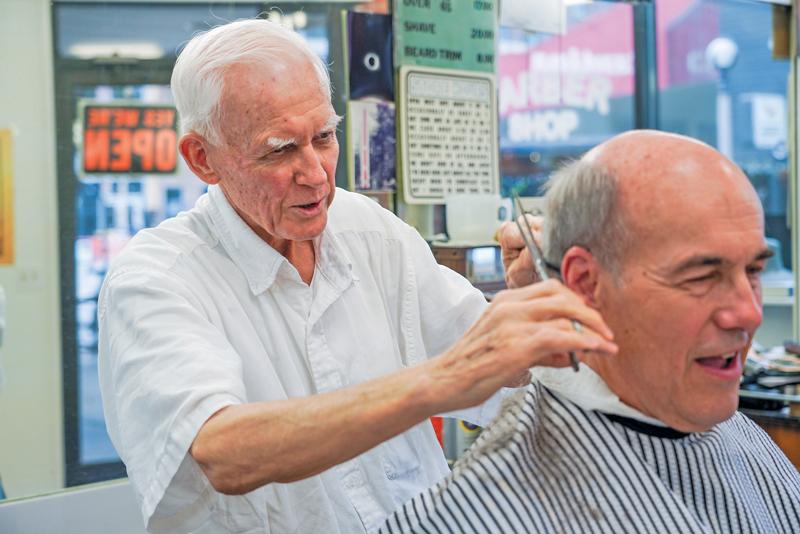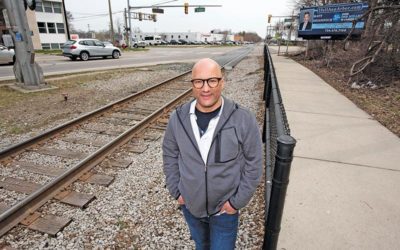Retired pharmacy prof Duane Kirking has been getting his hair cut at Church Street Barbers since 1981, but the shop still holds surprises. As owner Jim Kemppainen, seventy-seven, gives Kirking a trim on a recent evening, he tells him about a visit by a pair of sixty-ish brothers who’d had their first haircuts here as children.
“They said, ‘Wow, this is just like it was,'” Kemppainen recounts. “And they opened that lower cabinet,” he says, pointing an elbow at the chipped white cupboard where I’ve set down my phone to record the interview.
I lean over and open the door, revealing orange bags filled with Tootsie Roll Pops. “I’ve had people older than I am come in wanting to know if the Tootsie Roll Pops are still there,” Kemppainen says.
It seems he shares that information on a need-to-know basis. Kirking had no idea.
—
Slight but square-shouldered, wearing jeans and a short-sleeved white dress shirt, Kemppainen reveals only what he wants to. When I ask what customers like to talk about, he gives me a blank look. “If they want to talk, I listen,” he deadpans. “At least, they think I’m listening.”
On the history of the shop though, he’s practically loquacious. He’d thought this was the shop’s centenary year, because an elderly U-M prof told him it opened in 1919, saying he’d watched it being built as a U-M undergrad.
The prof might have been thinking of grad school, because the shop just off South U doesn’t show up in the Polk city directories until 1926. But the directories confirm the rest of the shop’s oral history: Claude Pearsall had it from the 1930s through the mid 1950s, when Martin “Barney” Barnhardt took over.
Kemppainen arrived in 1980. “The professors were quick to tell me, ‘Don’t change anything,'” he recalls. “I thought, ‘well maybe when Barney retires.'” But when the time came a few years later, he decided, “Well, the business is here and it works. So if it’s not broken, don’t mess with it, you know?”
Fluorescent lights hang incongruously from the pressed tin ceiling, and the chrome-and-vinyl waiting chairs might have been new around 1950. But passing Generation Z students now catch glimpses of themselves in the same mirrored walls that once reflected 1920s flappers. When Kemppainen checks the patent dates on the three barber chairs, he seems pleased that all predate WWI.
Yet as he approaches his fortieth anniversary cutting hair on Church St., he sometimes wonders how he ended up devoting his life to a historic business.
“I just came here for a part-time job,” he says. “I thought, a year or two and that’s it.”
—
Kemppainen grew up on a farm in Tapiola, in Michigan’s remote Keweenaw Peninsula. He and his brother walked a mile to the school bus stop, and, since the school was only a mile further, often just kept walking. Given the Keweenaw’s epic snowfalls, that sounds pretty rugged–until he adds that their father skied ten miles through the woods to work at a lumber camp, sometimes shooting partridge for dinner on his way home.
Along with minerals and lumber, the U.P. exports young people. Like about half his high school class, Kemppainen left town after graduation in 1960.
He went into the Army, “jumped out of planes” as a paratrooper, and just missed Vietnam: “My buddies were in combat ninety days after I got out.” He worked briefly in a copper mine, married a girl from Tapiola, and moved to what Yoopers call “downstate.”
What brought them to Ann Arbor? “Just luck,” he says. “I didn’t know anything about it.”
He started out working construction (his first job was in Milan, rebuilding after a tornado) then went to the Detroit Barber College and apprenticed at Dascola’s.
He figured he’d cut hair while studying biology and chemistry at EMU. But then he landed a job as a union truck driver. Making good money delivering new cars all over the country, he never went back to school.
Comparing timelines, I realize that he must have hauled some of the cars I built when I worked at a Ford plant in Wayne in the 1970s. Kemppainen is not as surprised as I am. He thinks a lot about life’s random twists and turns.
Talking to his father before his death four years ago, he learned that his mother’s parents had left the U.P. when she was a child. His grandfather had hopes for a better life in New York City–but, stopping with relatives in Cleveland, he somehow hurt his hand. Figuring no factory would hire him, he turned around and drove back to Tapiola.
“If my grandfather hadn’t injured his hand, I wouldn’t even have been born,” Kemppainen muses, “because my mother would have been in New York, and my father would have married someone else.”
—
The trucking company abruptly closed during the 1979 energy crisis. Kemppainen’s daughter had just started school and his wife wanted to go back to work. A part-time job would let him double as a househusband.
“But Barney didn’t want an employee–he wanted a partner,” Kemppainen says. “So I became a partner.” He did get Barnhardt’s permission to install the shop’s first telephone, in case his daughter’s school called.
Less than a year later, Duane Kirking started getting his haircut there. Two years after that, Barnhardt’s wife got sick. He retired to care for her and asked Kemppainen to buy his shares. Though he’s had other barbers here, he’s been the sole owner ever since.
—
Long divorced, his daughter grown and living in South Carolina, Kemppainen has time for avocations. A twenty-five-year member of the Ann Arbor Ski Club, he says last winter was the first he didn’t ski. He’s also a glider pilot, co-owning a Standard Cirrus with another member of the Sandhill Soaring Club in Gregory.
What drew him to it? Compared to jumping out of planes, he says, “it lets you stay up longer.”
He’s kept his ties to the U.P., where he owns the farmhouse where his ex-wife grew up. A lot of his classmates who left, he says, are now retiring and moving back.
Does he ever think about doing that himself?
“My brother was dreaming about retirement in third grade,” Kemppainen says. “And he became a schoolteacher, and he did.
“But in my case, it never even occurred to me to have a job where I retired.
“I just keep going and going as long as I can. And that’s it, you know?”




